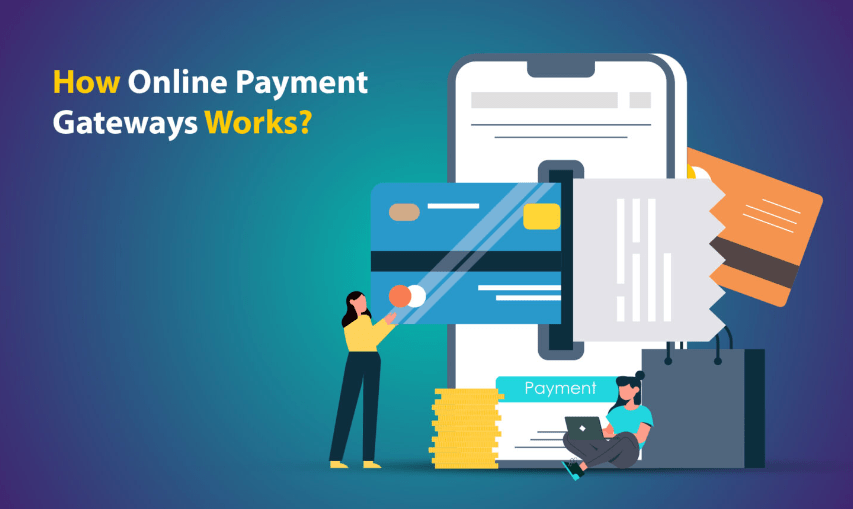To work online payment gateway, you need to sign up with a payment service provider, integrate the gateway into your website, and set up the necessary security features. This will enable you to securely process online transactions and accept payments from your customers.
In today’s digital age, having the ability to process online payments is crucial for businesses looking to expand their customer reach and streamline their sales process. By leveraging an online payment gateway, businesses can offer a convenient and secure way for customers to make purchases, leading to increased sales and customer satisfaction.
Additionally, integrating an online payment gateway allows businesses to manage and track transactions efficiently, providing valuable insights to drive business growth. With the right approach, businesses can harness the power of online payment gateways to create a seamless and secure payment experience for their customers.
Understanding Online Payment Gateways
Understanding online payment gateways is essential for businesses venturing into e-commerce. Online payment gateways facilitate secure and seamless online transactions, allowing businesses to accept payments from customers worldwide. In this article, we will delve into the importance of having an online payment gateway and explore the core functionalities that are crucial for efficient and reliable payment processing.
Importance Of Having An Online Payment Gateway
Implementing an online payment gateway is crucial for businesses operating in the e-commerce landscape. Having an online payment gateway not only enhances the customer experience but also instills trust and credibility in the online transaction process. It enables businesses to cater to a global customer base, accepting payments in various currencies, and significantly expanding their market reach. By offering secure and convenient payment options, businesses can build customer loyalty and drive sales growth.
Core Functionalities Of An Online Payment Gateway
Online payment gateways encompass several core functionalities that are vital for the smooth and secure processing of transactions. These functionalities include:
- Transaction Encryption: Online payment gateways employ robust encryption methods to safeguard sensitive payment information, ensuring secure data transmission between the customer’s device and the merchant’s website.
- Payment Processing: The gateway facilitates the authorization, processing, and settlement of online payments, seamlessly integrating with various payment methods such as credit/debit cards, digital wallets, and bank transfers.
- Fraud Prevention: Advanced fraud detection measures and validation protocols are integrated into payment gateways to mitigate the risk of fraudulent transactions and enhance transaction security.
- Customer Authentication: The gateway provides mechanisms for customer authentication, including two-factor authentication and secure login processes, to validate the identity of the payer and minimize fraudulent activities.
- Integration Capabilities: Payment gateways offer seamless integration with e-commerce platforms and websites, enabling businesses to incorporate payment processing functionalities without disrupting the user experience.
Choosing A Payment Gateway
When it comes to choosing a payment gateway for your online business, there are several key factors to consider in order to make an informed decision. Selecting the right payment gateway is crucial for ensuring secure and seamless transactions for your customers, as well as optimizing your business operations. Here are the key aspects to keep in mind when evaluating different payment gateway options.
Compatibility With Your Business Model
Compatibility with your business model is a critical aspect to consider when choosing a payment gateway. Before making a decision, assess whether the payment gateway supports the specific requirements of your business. Whether you operate an e-commerce store, a subscription-based service, or a freelance business, ensure that the payment gateway aligns with your unique business model and caters to your specific needs. Moreover, consider factors such as the types of payments accepted (credit cards, ACH transfers, digital wallets, etc.) and the geographical regions supported.
Security Features And Compliance Standards
Ensuring the security of your customers’ sensitive payment information is paramount. Look for a payment gateway that offers robust security features, such as encryption, tokenization, and fraud detection mechanisms to safeguard against potential threats. Additionally, prioritize payment gateways that adhere to industry compliance standards such as PCI DSS (Payment Card Industry Data Security Standard) to guarantee the highest level of data protection and compliance with regulatory requirements.
Pricing Structure And Fee Analysis
When assessing payment gateways, it’s crucial to examine the pricing structure and associated fees in detail. Different payment gateways may have varying fee structures, including setup fees, monthly subscription fees, transaction fees, and additional charges for international transactions or currency conversions. Create a comprehensive fee analysis to understand the true cost implications of each payment gateway and evaluate how these fees align with your business’s budget and transaction volume.
Setting Up The Payment Gateway
Setting up the payment gateway is crucial for processing online transactions. To work with an online payment gateway, merchants need to integrate the gateway with their website or platform. This involves following the gateway’s setup instructions, configuring account settings, and testing the payment process to ensure it functions smoothly.
Registration And Merchant Account Creation
Setting up an online payment gateway involves a series of essential steps that can seem complex initially. However, with the right guidance, the process becomes much simpler. The first step in setting up a payment gateway is to register with the chosen payment service provider or a third-party payment gateway solution. During the registration process, you will need to provide critical information such as your business details, contact information, and banking details. After successful registration, you will also need to create a merchant account, which is essential for processing online transactions. This account serves as a bridge between your website and the payment gateway, allowing you to receive and manage payments effectively.
Integrating The Gateway With Your Website
Once your merchant account is established, the next step is to integrate the payment gateway with your website. This involves adding the necessary code to your website’s checkout page or online store. Most payment gateway providers offer developer-friendly APIs and plugins that simplify this integration process. Depending on your website’s platform (e.g., WordPress, Shopify, Magento), you can choose a suitable integration method that aligns with your technical skills and requirements. It’s essential to follow the provider’s guidelines and documentation to ensure a smooth and secure integration process.
Testing The Payment Process
After integrating the payment gateway, thorough testing is crucial to ensure the payment process functions flawlessly. You can conduct test transactions using sandbox or test card details provided by the payment gateway. This allows you to verify the functionality of your payment gateway before going live. Testing the payment process helps identify and resolve any potential issues related to payment authorization, confirmation, and error handling. Once the testing phase is successfully completed, you can proceed with confidence, knowing that your payment gateway is fully operational and ready to process real transactions.
How Payment Gateway Processing Works
Online payment gateway processing involves the seamless transfer of customer payment information to the merchant’s bank. Encrypted data ensures secure communication between the customer, merchant, and payment processor, allowing for swift, reliable transactions. This allows businesses to accept various payment methods, enhancing customer convenience and satisfaction.
The Role Of Payment Gateways In Transactions
In the digital age, payment gateways play a crucial role in facilitating secure transactions between buyers and sellers. Payment gateways act as a bridge between the merchant’s website and the financial institutions involved in the transaction. Utilizing encryption and secure protocols, these gateways ensure that sensitive payment information is transmitted securely from the customer to the merchant and then to the payment processor for authorization and settlement.
Step-by-step Payment Transaction Flow
The flow of a payment transaction through a gateway typically involves several steps. First, when a customer initiates a purchase on the merchant’s website, the payment gateway securely collects the payment details. These details are then transmitted to the acquiring bank for authorization. Upon receiving approval from the bank, the payment gateway forwards the authorization to the merchant, allowing the transaction to proceed. Subsequently, the gateway facilitates settlement, ensuring that funds are transferred from the customer’s account to the merchant’s account in a timely manner. “`html
Authorization And Settlement Process
The authorization process is a critical step that involves validating the customer’s payment details and ensuring that sufficient funds are available for the transaction. Once authorized, the settlement process commences, where the payment gateway collaborates with the involved financial institutions to transfer the funds from the customer’s account to the merchant’s account. This ensures that the merchant receives the payment promptly and securely, finalizing the transaction. In summary, payment gateways play a vital role in securing and facilitating online transactions, ensuring that both merchants and customers can engage in transactions with confidence and trust.
Managing Online Payments
Managing online payments is an essential aspect of running an e-commerce business. It involves efficiently handling transactions, processing refunds, managing chargebacks, and utilizing the available tools to ensure a seamless payment experience for both the business and its customers.
Dashboard Features And Management Tools
Online payment gateways provide businesses with a comprehensive dashboard equipped with a range of powerful features and management tools. The dashboard allows you to track and monitor transactions, view real-time reports, analyze payment trends, and manage customer data. Additionally, it provides insights into sales performance, enabling you to make informed decisions to optimize your payment processes and enhance customer satisfaction.
Handling Refunds And Chargebacks Effectively
Dealing with refunds and chargebacks is a critical aspect of managing online payments. Online payment gateways equip businesses with tools and procedures to handle refunds efficiently. This includes streamlining the refund process, issuing timely refunds to customers, and maintaining transparency throughout the entire transaction lifecycle. Moreover, effective management of chargebacks involves understanding the chargeback process, providing compelling evidence to dispute illegitimate chargeback claims, and minimizing the impact of chargebacks on your business.
Enhancing Customer Checkout Experience
Enhancing the customer checkout experience is crucial for any online business, as it directly impacts customer satisfaction and the likelihood of repeat purchases. Streamlining the checkout process, providing multiple payment options, and ensuring mobile-friendly payment solutions are essential elements in creating a seamless and efficient online payment gateway. By focusing on these aspects, businesses can optimize the customer checkout experience and ultimately increase conversion rates and customer loyalty.
Streamlining The Checkout Process
Streamlining the checkout process is essential to minimize the steps required for customers to complete their purchases. Simplifying the form-filling process and reducing the number of clicks can significantly improve the overall checkout experience. Implementing an auto-fill feature for customer details and providing guest checkout options can further expedite the process, leading to a higher conversion rate.
Providing Multiple Payment Options
Offering multiple payment options gives customers the flexibility to choose their preferred method, thereby enhancing convenience and reducing the likelihood of abandoned carts. By integrating various payment gateways such as credit/debit card, PayPal, and digital wallets, businesses can cater to a broader customer base and increase the chances of successful transactions.
Ensuring Mobile-friendly Payment Solutions
Mobile-friendly payment solutions are vital in today’s increasingly mobile-centric world. Ensuring that the online payment gateway is optimized for mobile devices allows for a smooth and seamless checkout experience across different screen sizes and operating systems. Implementing mobile payment options and enabling one-click payments can further streamline the process for mobile users, maximizing customer satisfaction and conversion rates.
Security Measures And Compliance
Security measures and compliance are essential components of any online payment gateway. They play a critical role in safeguarding sensitive financial data and ensuring that transactions are secure and protected from unauthorized access. In this section, we will delve into the specific security measures and compliance requirements that online payment gateways must adhere to in order to maintain a trusted and secure payment environment.
Encryption And Data Protection Mechanisms
Encryption and data protection mechanisms are pivotal in ensuring the security of online payment transactions. These mechanisms involve the use of cryptographic algorithms to encrypt sensitive cardholder data and other transaction information, thereby rendering it unreadable to unauthorized entities. By utilizing strong encryption protocols, online payment gateways can securely transmit and store sensitive data, preventing potential data breaches and fraud.
Understanding Pci Dss Requirements
The Payment Card Industry Data Security Standard (PCI DSS) is a set of security standards designed to ensure that all companies that accept, process, store, or transmit credit card information maintain a secure payment environment. Understanding and adhering to PCI DSS requirements is crucial for online payment gateways to protect cardholder data and prevent security breaches. Compliance with these requirements involves implementing robust security measures, conducting regular security assessments, and maintaining a secure network infrastructure.
Regular Security Audits and Updates
Regular security audits and updates are essential for ensuring the ongoing security and compliance of an online payment gateway. By conducting periodic security audits, businesses can identify and address potential vulnerabilities and weaknesses in their payment systems. This proactive approach helps in mitigating security risks and ensuring that the payment gateway remains resilient against evolving cyber threats and attacks. Additionally, staying abreast of security updates and patches is imperative in safeguarding the payment platform against known vulnerabilities and exploits.
Optimizing The Payment Gateway Performance
Payment gateway optimization is crucial for ensuring smooth transactions and a seamless user experience. By focusing on monitoring transaction success rates, analyzing and reducing declined transactions, and updating with new payment technologies, businesses can enhance the performance of their online payment systems.
Monitoring Transaction Success Rates
Regularly monitoring the success rates of transactions is vital for identifying any issues that may be affecting the payment gateway’s performance. By closely monitoring this data, businesses can quickly identify any declines or delays in transaction processing, allowing them to take immediate action to rectify the issues and improve performance.
Analyzing And Reducing Declined Transactions
Analyzing the reasons behind declined transactions is essential for optimizing the payment gateway’s performance. By identifying common reasons for declines, such as expired cards or insufficient funds, businesses can take proactive steps to reduce these issues, thereby increasing the overall success rate of transactions and minimizing the risk of lost revenue.
Updating With New Payment Technologies
Staying up to date with the latest payment technologies is crucial for ensuring that the payment gateway remains efficient and secure. By regularly updating the payment gateway with new technologies, such as tokenization or biometric authentication, businesses can enhance the security and convenience of the payment process, improving the overall performance and user experience.
Frequently Asked Questions On How To Work Online Payment Gateway
What Is An Online Payment Gateway?
An online payment gateway is a technology that authorizes credit card or other forms of electronic payments for e-commerce transactions. It encrypts sensitive information to ensure secure transfer between a customer and the merchant.
How Does An Online Payment Gateway Work?
When a customer makes a purchase online, the payment gateway securely captures the credit card data, encrypts it, and sends it to the bank for authorization. Once approved, the money is transferred to the merchant’s account.
What Are The Benefits Of Using An Online Payment Gateway?
Using an online payment gateway offers several advantages, including increased security for transactions, a more convenient checkout experience for customers, and the ability to accept a variety of payment methods, such as credit cards and digital wallets.
What Security Features Does An Online Payment Gateway Provide?
Online payment gateways use encryption and tokenization to keep customers’ sensitive information secure. They also employ fraud detection tools to monitor transactions and prevent unauthorized use of credit cards.
Conclusion
To sum up, integrating an online payment gateway can streamline transactions and enhance customer experience. With seamless processes and secure transactions, businesses can tap into a global market and drive revenue growth. Keep in mind the tips mentioned in this post to effectively use online payment gateways for your business.





